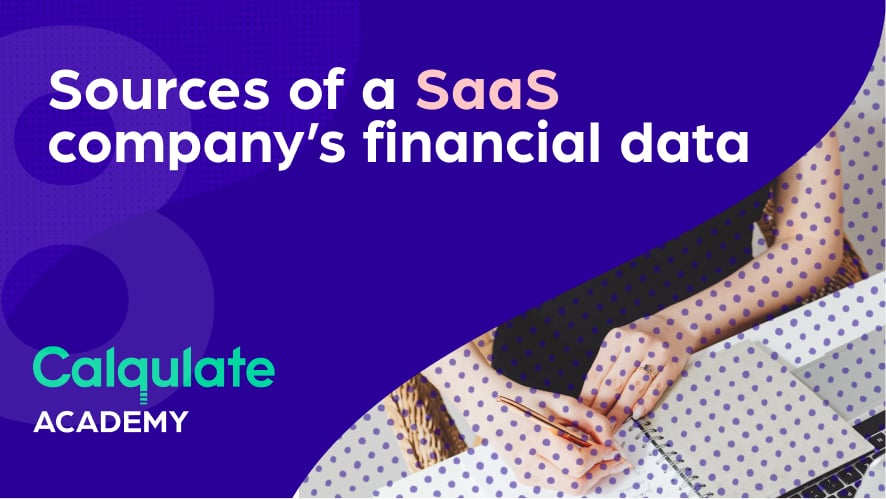The most important sources of financial data of a growth company are:
- Subscription/transaction management and payment software
- Accounting software
- CRM software
- Marketing platforms (Facebook ads, Google ads etc)
- Payroll software
- Expense management software
- App stores
- Banking data
Let’s look at each source separately. From a financial reporting perspective, items 1 and 2 build the foundation for financial analytics. Items 3 to 8 drill into the details and create insights from the high-level numbers that you obtain from sources 1 and 2 in the above list.
1. Subscription management and payment software
Especially for a SaaS company, the subscription management software is a key source of financial data. It's where you get most of the data for the KPIs that matter for your business. The subscription management software stores detailed information about your customers, payments, contract lengths, subscription changes and cancelled subscriptions. All these data points are needed to calculate your MRR, retention, average revenue per customer and LTV. These KPIs define the financial health of your company.
If you don’t have your subscription data in a legible and structured format, you cannot build any sensible financial reporting for a SaaS company. It's that simple. Get your subscription data organized first and then build your financial reporting on top of that.
The most commonly used subscription management softwares include Stripe, Chargebee, Recurly, Braintree and Zuora.
2. Accounting softwareEven though high-growth companies should mostly look forward and forecast their growth, the accounting software offers important financial reports and data points for investor reporting, financial analytics and valuation calculations. It offers
Information for Customer Acquisition Cost calculationYou can extract a lot of information for your CAC calculation from your accounting software. Most companies centralize and pay their vendor/supplier invoices through their accounting software and these are a possible source for CAC calculations
Data for investor reportingYour investors need the essential numbers from your Profit&Loss Balance sheet reports, such as total revenue, Gross Margin and EBITDA
Data for valuation modelsWant to know how much your company is worth now or in the future, based on your revenue forecasts? Most common valuation models are based on MRR, EBITDA multiples and Free Cash Flow calculations. You get the most of these numbers from the P&L and Balance sheet.
3. CRM softwareFor a sales-driven company, your CRM software offers the easiest way to predict short-term new revenue and split the high-level figures, such as new MRR, LTV, and churn:
- By sales rep - who’s the most productive and brings in most of the new revenues?
- By sales team - which team is the most effective?
- Between inbound and outbound sales - which one offers the shortest sales cycle and brings in more revenue?
The sales pipeline should always have a close date and a probability % for each deal, and if the historical sales data is stable, sales analytics can be used as a leading indicator for future growth, for example.
- New leads into the pipeline
- Leads converted to opportunities
- Lead-to-opportunity conversion rate
- Sales rep closing ratio
- Sales cycle length
To feed leads directly into your pipeline from your website, choose a CRM that seamlessly integrates with the other tools in your marketing stack (e.g. your website builder).
4. Marketing Platforms
Almost all digital businesses use a variety of digital marketing channels, such as their own blog, webinars or virtual events, Google ads, and Facebook ads, to build awareness and increase the number of leads in their marketing funnel. Each channel offers a different Return on Investment (Marketing ROI). Marketing analytics can, for example, be used as leading indicators for future growth. If you have decided to invest $100,000 in a marketing campaign, you need to anticipate when the investment will convert into new sales, revenue, and cashflow. Combining marketing analytics and financial analytics is key to building a tech company’s growth engine.
All your marketing expenditure needs to be allocated 100% to customer acquisition costs. The more you can split the marketing expenditure among product lines, plans, target countries, and customer segments, the more detailed LTV to CAC calculations you’ll be able to extract.
5. Payroll softwareYour staff costs are usually the biggest single item in your customer acquisition costs. That’s why you need to analyze your staff costs by country, department and employee. The salaries of sales and marketing staff are 100% allocated to customer acquisition costs, and part of your CEO’s and COO’s salaries should probably be allocated to CAC as well. Read more about CAC in our other academy article.
Your current and forecasted sales headcount should also be linked to your sales analytics, in order to predict future new sales and revenue.
6. Receipt & Expense management softwareSoftware license fees, digital marketing expenses, and other fees are paid with a credit card, and not with a wire transfer. In order to standardize the pre-accounting processes, classify expenditure and use it in CAC calculations and expenditure analytics, a Receipt & Expenditure management software is needed.
7. App stores
The Apple App Store and Google Play are gaining popularity as sales channels and many tech companies depend on the app store for their revenue streams. Many SaaS companies sell subscriptions through the app stores.
8. Banking data
Is your company’s available cash balance split between a traditional bank account, Stripe account, and Revolut (or other Neobank account)? Join the club - it's a pain! Ten years ago, companies could depend on having all their cash stored in one bank. Now that business is mostly digital, companies have multiple sales channels and fragmented revenue sources, and their cash is stored in many places. It is essential, for cash management and forecasting, to know the consolidated balance of your bank accounts, and to know the delays in being paid via different channels.
The EU Payment Services Directive, PSD2, has enabled access to open banking data and it has never been so easy to get a complete view of your bank transactions, balances, and credit card data.
Happy Calqulating!

